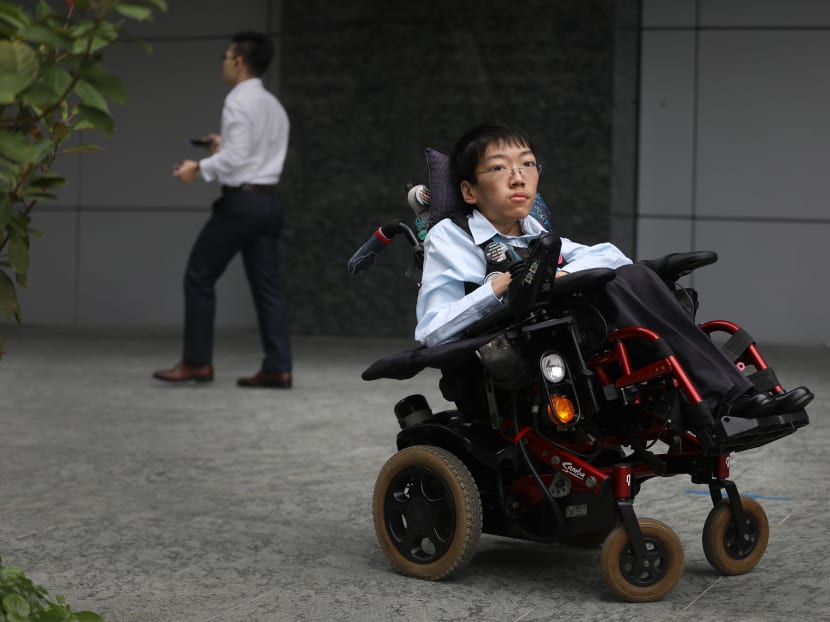The disabled stands to benefit from a telecommuting world. I speak from experience
The Covid-19 pandemic has forced people to quickly get to grips with using video conferencing, thereby speeding up its adoption. This practice is likely to stick even after the threat of Covid-19 has passed, experts believe. As a disabled person who will soon enter the workforce, I hope this prediction comes true, because based on my personal experience, I believe video conferencing will help disabled people integrate better into society.

The author, seen here on Nov 12, 2019 before the Covid-19 outbreak, says that driving around in a motorised wheelchair can be a challenge.
As people around the world stay home to flatten the Covid-19 curve, they are rapidly discovering virtual alternatives for activities they had long been doing in-person. Much of this is possible because of video conferencing or telecommuting software such as Zoom.
Video conferencing is not a new technology, but the Covid-19 pandemic has forced people to quickly get to grips with using it, thereby speeding up its adoption. This practice is likely to stick even after the threat of Covid-19 has passed, experts believe.
As a disabled person who will soon enter the workforce, I hope this prediction comes true, because based on my personal experience, I believe video conferencing will help disabled people integrate better into society.
Being a wheelchair user, one of the biggest obstacles I face is travel, which I define as the mere act of leaving my home. Unlike an able-bodied person, I can’t just get up and go wherever I want.
The logistics of transporting me invariably involves at least one other person — in most cases my father, who is my full-time caregiver.
He has to load me and my motorised wheelchair into the back of his car, drive me to my destination, then unload the wheelchair and walk with me to where I need to go in case I encounter lifts or gantries that I cannot navigate on my own.
I have no doubt that as far as the disabled community in Singapore goes, I am one of the luckier ones. My parents not only care for me and are willing to do everything in their power to give me the best possible chance to succeed in life, they also possess the resources to do so.
Some disabled people are less fortunate. They may not have a family car to ferry them around, or a parent who can afford to stop working to take care of them. For them, getting around is even more of a problem than it is for me and they end up stuck at home, unseen and unheard.
Another factor makes leaving my home a big decision for me, and probably other disabled people too: Fatigue.
It is tiring being out. Although my wheelchair is motorised, driving around is still a challenge, especially over long distances or in a cramped environment where I have to manoeuvre carefully.
Because my muscles are weak, even turning my head or keeping my balance requires much effort.
Staying out for too long also causes aches and pains to build up on the parts of my body that are in contact with the wheelchair — I lack the strength to wriggle about to relieve some of the pressure.

Contrast this to what happens when I use my laptop at home, like I am doing right now as I write this. I don’t have to expend energy turning my head since the laptop is stationary in front of me.
Yes, it takes a bit of effort to stay seated in an upright position, but since I am not moving, I have a stable base and so use a lot less energy than driving a motorised wheelchair.
At home, I can also lie in bed anytime I want to banish any aches and pains. All in all, I am much more comfortable.
The net effect of this is tremendous. My mind is a lot sharper when it does not have to worry about what is happening to my body. I do my best work alone at home, with only my laptop for company.
So the rise of telecommuting because of Covid-19 has been a blessing in disguise for me.
When my university switched to Zoom classes, my participation in class improved. I transformed from being that invisible guy in the corner to giving my inputs in almost every lesson, first through the text-based chat function and then, as I slowly grew more confident, by speaking into the microphone.
As the semester drew to a close, project presentations were also held on Zoom and I found them much less stressful.
Group assignment meetings via video conferencing also mean my father no longer has to drive me across the island just to attend a one- to two-hour discussion on campus.
In short, telecommuting has been extremely beneficial for me, and I think these benefits apply to other disabled people too.
By removing the obstacles that travelling poses, telecommuting allows disabled people to lead more active professional and social lives.
For example, I recently agreed to be a panellist at an event on inclusiveness in the business world which is being planned as a webinar to be held a couple of months from now. I would have hesitated to accept the invitation if the event is a traditional seminar in a physical venue.
As a media student and aspiring professional in the field, it also excites me to see journalists using video conferencing to conduct interviews remotely.
If this practice survives beyond the Covid-19 outbreak, I envision a future in which disabled people will be better represented in the media.
There are many educated disabled people with opinions to share. Some may even be subject matter experts in their respective fields.
But they are seldom quoted by the media, probably because it is logistically more difficult to set up interviews with them. In this respect, video-conferencing can — to borrow the cliché — level the playing field.
For the less fortunate, this levelling effect is even more significant.
A computer isn’t cheap, but it costs just a fraction of the price of a car while fulfilling nearly the same purpose thanks to the power of telecommuting. With it, they will finally be able to be more involved in societal affairs alongside the rest of the community.
The safe distancing measures necessitated by the coronavirus pandemic have shown us that it is possible to do so much using technological tools that have been at our disposal all along. All we need to do now is change our mindset as a society and embrace new and improved ways of living, working, and playing.
This will improve social equality by providing more opportunities for the marginalised disabled community to thrive and excel.
ABOUT THE AUTHOR:
Jonathan Tiong is a fourth-year student at the National University of Singapore where he is majoring in Communications and New Media.






